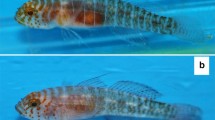Synopsis
Observations of the Caribbean eyed flounder,Bothus ocellatus, were made during two field trips to Bonaire, Netherlands Antilles (January 1990, and December 1990 – January 1991) at depths from 3 to 6 meters. Data were collected by six scuba divers during 54 dives totaling 70 hours. Three mating groups were observed, each consisted of a male and 1 to 6 females. Each female had a distinct subunit within the male's territory. Courtship activity began about one hour before sunset and continued until sunset, when the male retired for the night. Both males and females retired into the sand at locations outside their daytime territory. Every day, males attempted to mate with each female individually within their territory. Spawning began with the male moving under the female who was resting on the sandy bottom. The pair then made a slow upward rise approximately 15 to 75 cm above the substrate, which culminated in a release of a cloud of gametes.Bothus lunatus andBothus ellipticus exhibited similar social organization toB. ocellatus, but differences in the spawning rise were observed. Intraspecific agonistic behavior was observed within males ofB. ocellatus andB. ellipticus.
Similar content being viewed by others
References cited
Amaoka, K., S. Nishikawa & N. Tanaka. 1974. Sexual dimorphism and an abnormal intersexual specimen in the bothid flounderBothus pantherinus. Japan. J. Ichthyol. 21: 16–20.
Butler, D.W. 1897. Reports on the spawning of the common sole in the aquarium of the Marine Biological Association Laboratory during April and May, 1895. Journal of the Marine Biological Association of the United Kingdom 4: 3–9.
Clark, E., J. Rabin & S. Holderman. 1988. Reproductive behavior and social organization in the sand tilefish,Malacanthus plumieri. Env. Biol. Fish. 22: 273–286.
Clark, E., M. Pohle & J. Rabin. 1991. Stability and flexibility through community dynamics of the spotted sandperch. National Geographic Research & Exploration 7: 138–155.
Donaldson, T.J. 1986. Courtship and spawning of the hawkfishCirrhitichthys falso at Miyake-jima, Japan. Japan. J. Ichthyol. 33: 329–333.
Donaldson, T.J. 1990. Reproductive behavior and social organization of some Pacific hawkfishes (Cirrhitidae). Japan. J. Ichthyol. 36: 439–458.
Forster, G.R. 1953. The spawning behaviour of the plaice. Journal of the Marine Biological Association of the United Kingdom 32: 319.
Hobson, E.S. 1972. Activity of Hawaiian reef fishes during the evening and morning transitions between daylight and darkness. U.S. Fish. Bull. 70: 715–740.
Künne, C. 1930. Aquarienbeobachtungen am Zwergbutt,Zeugopterus punctatus. Intern. Rev. gesamten Hydrobiol. Hydrographie 24: 134–139 (in German).
Moyer, J.T., Y. Yogo, M.J. Zaiser & H. Tsukahara. 1985. Spawning behavior and social organization of the flounderCrossorhombus kobensis (Bothidae) at Miyake-jima, Japan. Japan. J. Ichthyol. 32: 363–367.
Nemtzov, S.C. 1985. Social control of sex change in the Red Sea razorfishXyrichtys pentadactylus (Teleostei, Labridae). Env. Biol. Fish. 14: 199–211.
Norman, J.R. 1934. A systematic monograph of the flatfishes (Heterosomata). Trustees of the British Museum, London. 459 pp.
Randall, J.E. 1961. Observations on the spawning of surgeonfishes (Acanthuridae) in the Society Islands. Copeia 1961: 237–238.
Randall, J.E. & H.A. Randall. 1963. The spawning and early development of the Atlantic parrot fish,Sparisoma rubripinne, with notes on other scarid and labrid fishes. Zoologica 48: 49–60.
Sato, Y. 1975. On the spawning behavior of the flatfish hiji shiroshita karei (Limanda yokohamae) in an aquarium-II. Suisan Zoshoku (The Aquiculture) 23: 33–35 (in Japanese).
Sato, Y. 1976. Studies of hiji shiroshita karei (Limanda yokohamae). Midori-Shobu, Tokyo. 100 pp (in Japanese).
Victor, B.C. 1987. The mating system of the caribbean rosy razorfish,Xyrichtys martinicensis. Bull. Mar. Sci. 40: 152–160.
Author information
Authors and Affiliations
Additional information
Senior author
Rights and permissions
About this article
Cite this article
Konstantinou, H., Shen, D.C. The social and reproductive behavior of the eyed flounder,Bothus ocellatus, with notes on the spawning ofBothus lunatus andBothus ellipticus . Environ Biol Fish 44, 311–324 (1995). https://doi.org/10.1007/BF00008245
Received:
Accepted:
Issue Date:
DOI: https://doi.org/10.1007/BF00008245




